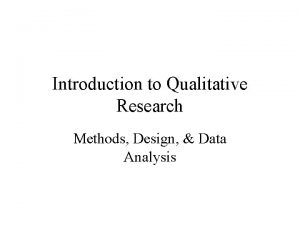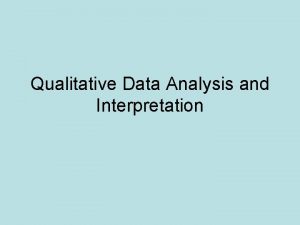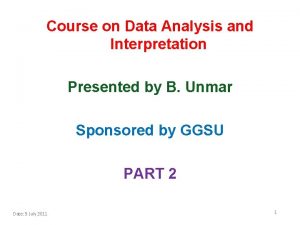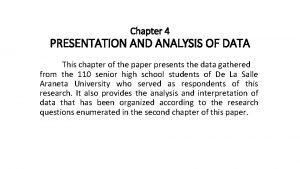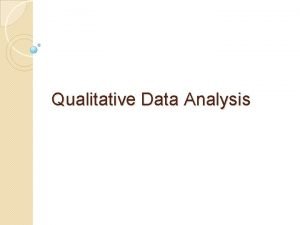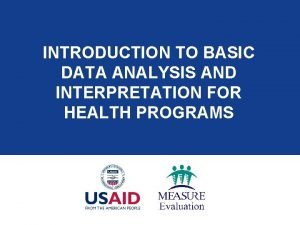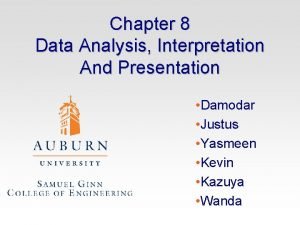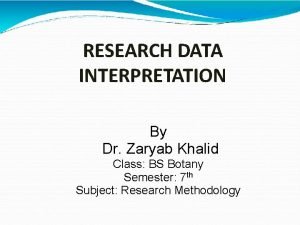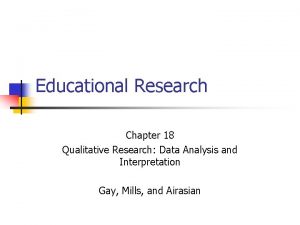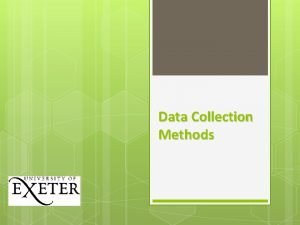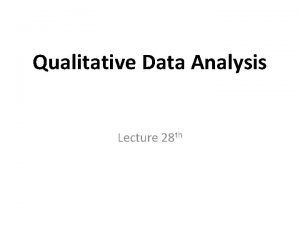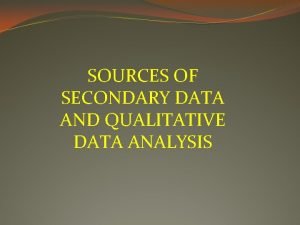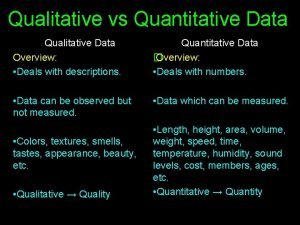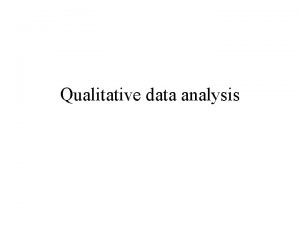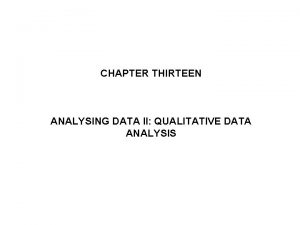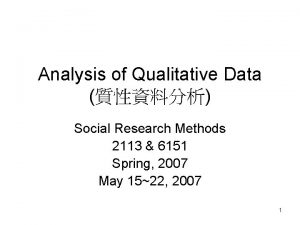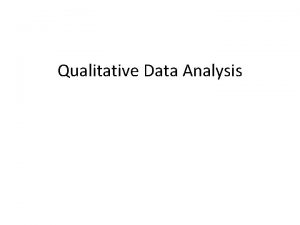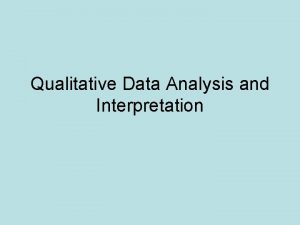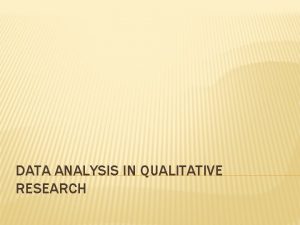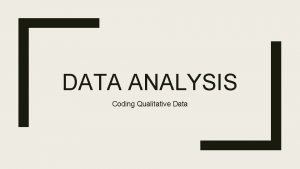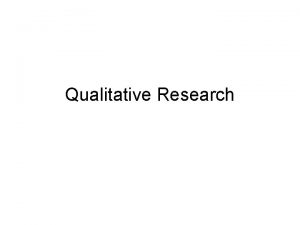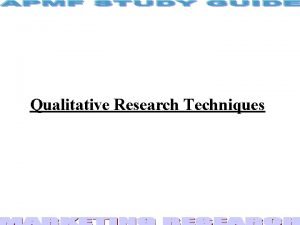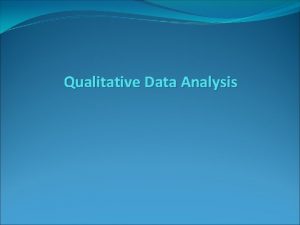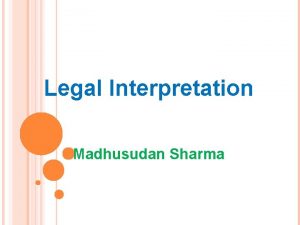Qualitative Research Data Analysis and Interpretation Teacher name


























- Slides: 26

Qualitative Research: Data Analysis and Interpretation Teacher name: Mahvish Fatima Kashif

Topics Discussed in this Chapter � Data ◦ ◦ analysis Characteristics of qualitative data Analysis during and after data collection Analytic strategies Computerized analysis � Interpretation of results ◦ Insights into interpreting ◦ Strategies

Data Analysis � The purpose of data analysis is to bring order to the data � Characteristics of qualitative data ◦ Thick, rich descriptions ◦ Voluminous ◦ Unorganized � Perspectives on analysis and interpretation ◦ No single way to gain understanding of phenomena ◦ Numerous ways to report data

Cont. � Perspectives ◦ Researcher’s messages are not neutral ◦ Researcher’s language creates reality ◦ Researcher is related to what and who is being studied ◦ Affect and cognition are inextricably linked ◦ What is understood is not neat, linear, or fixed

Data Analysis During Data Collection � Data analysis is an ongoing process throughout the entire research project ◦ Analysis begins with the very first interaction between the researcher and the participants ◦ This is a very important perspective given the interpretive nature of the analysis and the emergent nature of qualitative research designs � Informal steps involve gathering data, examining data, comparing prior data to newer data, and developing new data to gain perspective

Data Analysis After Data Collection � General guidelines and strategies but few specific rules � Common problems ◦ Premature conclusions ◦ Inexperience of the researcher ◦ Self-reinforcement of the researcher’s own ideas without support from the data ◦ Impulsive actions ◦ Desire to finish quickly � Most problems are resolved by spending time “living” with the data

Cont. � Inductive nature of data analysis ◦ Large amount of data to analyze ◦ Progressively narrowing data into small groups of key data ◦ Multi-staged process of organizing, categorizing, synthesizing, interpreting, and writing

Cont. � Iterative process focused on ◦ Becoming familiar with the data and identifying potential themes ◦ Examining the data in-depth to provide detailed descriptions of the setting, participants, and activities ◦ Coding and categorizing data into themes ◦ Interpreting and synthesizing data into general written conclusions

Cont. � Data management ◦ Creating and organizing data collected during the study ◦ Purposes �Organize and check data for completeness �Start the analytical and interpretive process ◦ No meaningful analysis can be done without effective data management

Cont. � Data management (continued) ◦ Suggestions �Write dates on all notes �Sequence all notes with labels �Label notes according to type �Make photocopies of all notes �Organize computer files into folders according to data types and stages of analysis �Make backup copies of files �Read through data to make sure it is legible and complete �Begin to note potential themes and patterns that emerge

Cont. � Three formal steps to analyze data ◦ Reading and memoing ◦ Describing the context and participants ◦ Classifying and interpreting

Reading and memoing ◦ Reading field notes, transcripts, memos, and the observer’s comments ◦ The purpose is to get an initial sense of the data ◦ Suggestions �Read for several hours at a time �Make marginal notes of your impressions, thoughts, ideas, etc.

Description ◦ What is going on in the setting and among participants �Purposes �Provide a true picture of the setting and events to understand appreciate the context �Separate and group pieces of data related to different aspects of the setting, events, and participants �Issues �The influence of context on participants’ actions and understanding

Classifying and interpreting ◦ The process of breaking down data into small units, determining the importance of these units, and putting pertinent units together in a general interpretive form ◦ Use of coding and classifying schemes �Topic – A basic unit of information �Category – a classification of ideas or concepts �Pattern – a relationship across categories

Eight strategies for starting data analysis ◦ Identifying themes �A good place to start analyzing data �Listing themes or patterns you have seen emerge from the data ◦ Coding data �Reducing the data to a manageable form �Guidelines �Read through all the data and attach working labels to blocks of text �Cut and paste these blocks of text to index cards to make it easier to organize the data in various ways �Group the index cards together based on similar labels �Re-visit each group of cards to be sure each card still fits

Cont. ◦ Asking key questions �Working through a series of questions such as those proposed by Stringer (e. g. , who is centrally involved, who has resources, how do things happen, etc. ) ◦ Doing an organizational review �Focus on the organization’s vision and mission, goals and objectives, structures, operations, problems, issues, and concerns ◦ Concept mapping �Create a visual representation of the major influences that have affected the study

Cont. ◦ Analyzing antecedents and consequences �Mapping causes and effects ◦ Displaying findings �Represent findings in effective visual displays (e. g. , graphs, charts, concept maps, etc. ) ◦ Stating what is missing �Identify what “pieces of the puzzle” are still missing

Computerized Data Analysis is readily available to assist with data analysis � Software ◦ Researchers must code the data ◦ Manipulation of the data is enhanced ◦ The effectiveness of this manipulation is dependent on the researcher’s ideas, thoughts, hunches, etc. � There is considerable debate as to whether data should be analyzed by hand or computer

Interpretation � The purpose of the interpretation of qualitative analyses of data ◦ Attempts to understand the meaning of the findings �Larger conceptual ideas �Consistent themes �Relationships to theory ◦ Differentiating analysis and interpretation �Analysis involves making sense of what is in the data �Interpretation involves making sense of what the data mean

Insights into interpretation ◦ Interpretation is reflective, integrative, and explanatory �Need to understand one’s own data to describe it �Integrated into report writing ◦ Based heavily on connection, common aspects, and linkages among data, categories, and patterns ◦ Interpretation makes explicit the conceptual basis of the categories and patterns

Four guiding questions ◦ ◦ What is important in the data? Why is it important? What can be learned from it? So what?

Six strategies ◦ Extend the analysis �Note implications that might be drawn ◦ Connect findings with personal experiences �The researcher knows the situation better than anyone else and can justify using his or her experiences and perspective ◦ Seek advice from a “critical” friend �Seek the insights from a trusted colleague ◦ Contextualize findings in the literature �Uncover external sources that support the findings

Cont. ◦ Turn to theory �Provides a way to link the findings to broader issues �Allows the researcher to search for increasing levels of abstraction �Provides a rationale for the work ◦ Know when to say, “When!” �Don’t offer an interpretation with which you are not comfortable �Suggest what needs to be done

Credibility Issues � Six questions to help researchers check the quality of their data ◦ Are the data based on your own observations or hearsay? ◦ Is there corroboration by others of your observations? ◦ In what circumstances was an observation made or reported?

Cont. ◦ How reliable are those providing data? ◦ What motivations might have influenced a participant’s report? ◦ What biases might have influenced how an observation was made or reported?

Thank You
 Interpretation of data in research example
Interpretation of data in research example Research appendices example
Research appendices example Chapter 3 research qualitative
Chapter 3 research qualitative Research qualitative or quantitative
Research qualitative or quantitative Qualitative approach
Qualitative approach Example of analysis and interpretation of data
Example of analysis and interpretation of data Example of analysis and interpretation of data
Example of analysis and interpretation of data Chapter four data presentation and analysis
Chapter four data presentation and analysis Deductive coding
Deductive coding Introduction of data analysis and interpretation
Introduction of data analysis and interpretation Data analysis, interpretation and presentation
Data analysis, interpretation and presentation Interpretation of data
Interpretation of data Interpretation of data in research example
Interpretation of data in research example How does interpretation b differ from interpretation a
How does interpretation b differ from interpretation a Narrative report with contextual description
Narrative report with contextual description Data analysis qualitative and quantitative
Data analysis qualitative and quantitative Research approach
Research approach Holistic perspective in qualitative research example
Holistic perspective in qualitative research example Domain analysis qualitative research
Domain analysis qualitative research Research instrument observation sample
Research instrument observation sample Qualitative data
Qualitative data Secondary data are
Secondary data are Qualitative vs quantitative data analysis
Qualitative vs quantitative data analysis Principles of qualitative data analysis
Principles of qualitative data analysis Miles and huberman 1994
Miles and huberman 1994 Characteristics of qualitative approach
Characteristics of qualitative approach Data
Data
